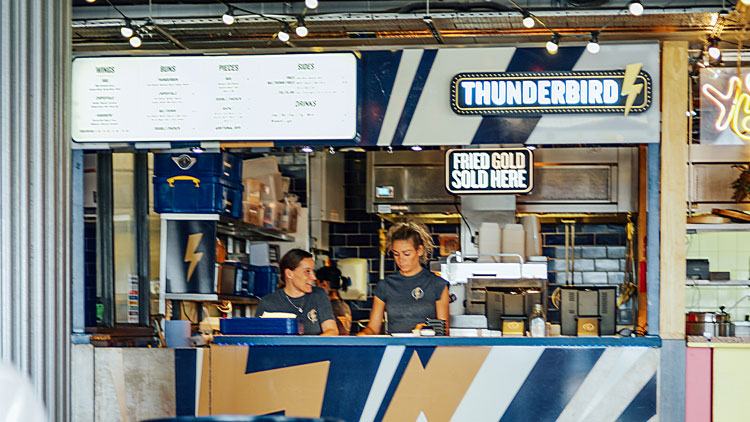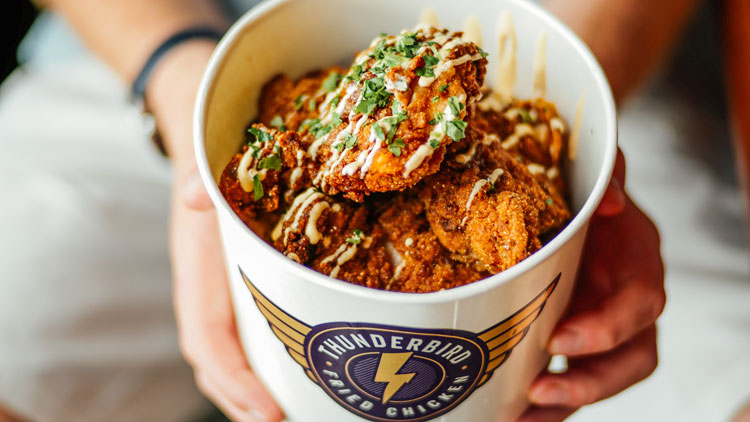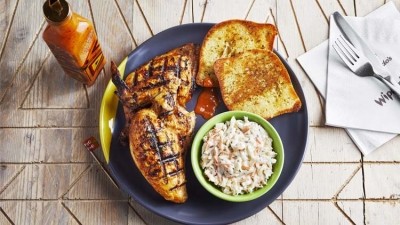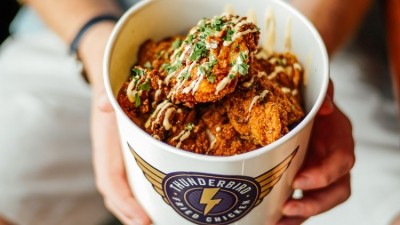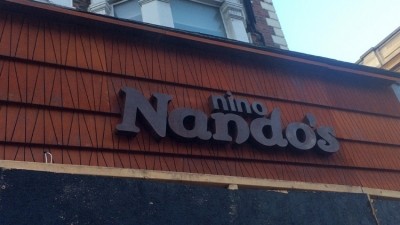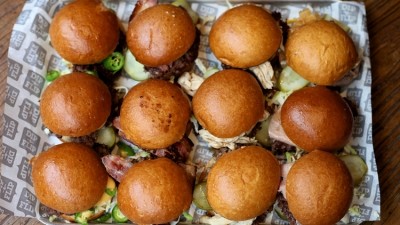Thunderbird are go: the fried chicken brand that's taking on KFC
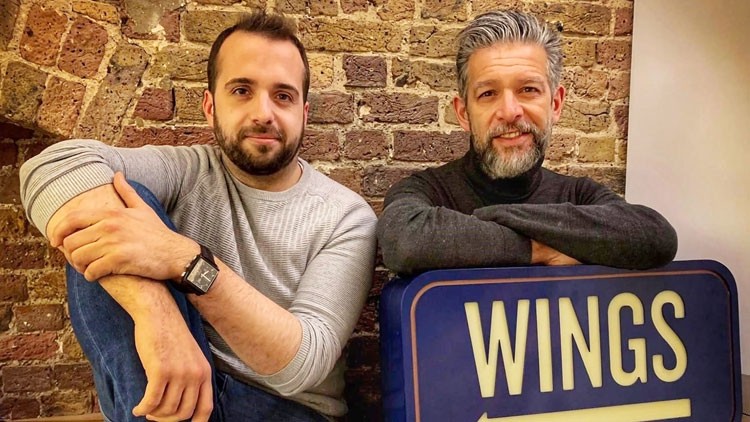
Every founder will have their own unique story of how they came to create their concept, but not many can match some of the key points that shaped that of Matt Harris, founder of street-food operation Thunderbird Fried Chicken (TFC). His back story includes a failed opportunity to race in NASCAR due to the recession in the US in 2008, a flatmate who found operating a toaster challenging, and a decision to put wings on a fledgling barbecue concept’s menu that completely changed the direction of his business.
Now, with the help of investment from private equity group TriSpan, his concept has made the leap from street food favourite – operating sites in the London Union-owned Dinerama in Shoreditch and Giant Robot in Canary Wharf – to a bricks and mortar entity in Brixton’s Market Row and a strong pipeline of openings on the horizon.
“It has certainly been an evolution,” says Harris, who grew TFC out of previous street-food concept BBQ Lab. Three months after he put wings on the menu it won the London WingFest competition. “We started looking for high-street sites to see what was out there. Around that time we began talking to more people and it just gradually snowballed from there.
“Then TriSpan appeared over the horizon at just the right time, at a stage when we were starting to build a pipeline ahead of us. It has picked up more momentum from there, and having them on board will put us on an incredibly steep trajectory.”
Sounding-board members
The concept had already generated interest and investment from Hippo Inns founders and Pizza Pilgrims backers Rupert Clevely and Ian Edward, as well as John Ayton, the entrepreneur behind Links of London. They were followed early on by Ivan Schofield, the ex-Itsu chief executive who knew a thing or two about fried chicken after a stint as managing director of KFC Western Europe.
“This was a badge of honour from the start,” says Harris. “They were perfect sounding-board members and great cheerleaders to have. Ian and Rupert were the first sector grown-ups I met. I didn’t realise how fortunate I was.”
All were impressed by the product, the excitement and loyalty it generated, and with Harris’ dedication to continuing to evolve and deconstruct his offer to make it the best it could be.
“Credit to Jonathan (Downey, founder of London Union), for taking a chance on us,” he says. “This is the best way to do a proof of concept, as there was no way anyone was going to invest in my hair-brained schemes and a few powerpoint slides a few years ago. It’s the perfect place to be if you are starting out; it is brutally competitive, there are new and innovative traders coming along every week. It challenges you constantly and gives you immediate consumer interaction and feedback.”
New investment expertise
The new investment has seen Schofield move from executive to non-executive chairman and Marcel Khan, who spent 10 years with Nando’s before playing a key role in the launch and expansion of US better burger brand Five Guys in the UK, France, Spain and Germany, join as chief executive. Kieran Sherlock, the former YO! Sushi property director, has come on board to assist with expansion opportunities.
Their expertise is also complemented by Brandon Stephens (founder of Tortilla) and Robin Rowland (former YO! Sushi CEO and TriSpan European operating partner), joining the Thunderbird board.
Despite the new investment and wealth of experience and expertise coming on board, Harris and Khan are determined that the business doesn’t forget its roots. “Much as we are progressing out of street food, we want to keep our ties to it, ensuring we don’t become a giant, soulless machine, and stick to our roots,” says Harris. “Street food is about having good food and good times and we want to continue that.”
Khan picks up the point: “There are two elements of energy in the street-food scheme. One is innovation. Having the continued connection to street food will help us continue to innovate. And two, you are surrounded by excitement. Something new is always coming along, so you are always seeing consumers getting excited by food – you are closer to that passion.
“You also have to stay on point, because the minute you are not as good as the guy next to you, that guy will eat you up. You can see where the crowds go here. In this environment it is a daily reminder of how well you are fighting in the arena.”
Sites in the pipeline
Having opened its first permanent site in Brixton earlier this year, TFC’s expansion plans are impressive, with four more sites set to open in relatively quick succession. Up next is a site at London’s O2 following the opening of ICON Outlet, a 210,000 sq ft ‘premium urban outlet’ development in Greenwich, followed by the team’s first in central London, which will open later this month on Villiers Street, the avenue that connects Covent Garden to The Strand.
“When Matt and I got chatting we got some key landlords down to try the food,” recalls Sherlock. “The response was staggering. These landlords now want this kind of product in their schemes. We can get into sites others can’t and there are still more opportunities to come to market.”
“If we are going to be successful we need to be versatile and work in pretty much any environment,” adds Harris. “We are building the business model around that, so we can do a really strong counter-service format but can also do a much more high-street, in-line model, which is going to increase dwell time.”
The perfect size of the format is between 1,000-1,500 sq ft, with the company saying it will be careful about its property strategy with each new location, with demand a key factor. That said, this is unlikely to restrict its expansion ambitions. “We will go where there is a demand, and we see demand for better chicken everywhere,” says Khan.
Harris offers a more cautious tone. “We are not looking to conquer the universe in 2019; we are looking to make smart, informed steps forward with something that is really precious to all of us. We will only know when to take the next steps once we have taken the first few.” As Khan points out, you can’t map a market “that doesn’t exist yet”.
Breaking unhealthy connotations
While the better burger scene has spread nationally, and the better pizza scene is following in its wake, the better chicken, especially fried chicken, movement has still to truly take off. Reasons for this are varied – from the power that KFC wields to the fact there isn’t the same consumer appetite to pay extra for better quality chicken as there is in the burger category. In terms of fried chicken, this is still a category many consumers associate with unhealthy takeaways.
The challenge for operators has been to change this consumer mindset around fried chicken being a value-led, unhealthy fast food to a more premium-yet-affordable eating-out experience. The sector’s own behemoth, KFC, which currently operates more than 900 restaurants in the UK and is expanding at around 30 sites a year, has been evolving over the past decade to match this need, working hard to change perceptions around its brand and product. Earlier this year, it vowed to revamp its menu and remove 20% of calories ‘per serving’ by 2025. The fact that its like-for-like sales last year, pre-supply issues saga, were up a healthy 5% shows the market opportunity is there still.
Over the past few years there have been a number of concepts to enter the market – Clockjack Oven and Whyte & Brown – but none, despite their rhetoric, has managed to make the next step. Further momentum has been brought into the category recently with the launch of CHIK’N, Slim Chickens, Wing Wing, Butchies, Orange Buffalo and Wingstop, leading to the thought that a breakout concept or two is ready to fly.
The fast-food sector in the US has become obsessed with chicken in the past few years: of the 100 biggest restaurant chains in the US in 2017, three of the five fastest-growing were chicken concepts. The chicken sector has been the number one category in the fast-food business in the States by purchase consideration since April 2016, when it eclipsed the burger sector. Fried chicken has been established as one of the most marketable types of fast food and, in recent years, Chick-fil-A has become the number one chicken chain in the US by sales.
But what about the UK? Harris says he has been buoyed by the fact that within the space of a few months of being ready to start TFC, a number of other chicken start-ups came into the space. “That gave me confidence that others had seen that the fried chicken category wasn’t very good. Fried chicken in the US was, in my mind, more prolific that burgers, so why wasn’t it the same over here?”
“Everyone is trying to up their chicken game and there are some good operators out there,” Khan adds. “But it’s an education play for the sector still.”
To this end, TFC has kept its offer very simple. Its menu comprises wings of various heat – BBQ, chipuffalo, and habanero – as well as boneless fried chicken pieces available by the box or bucket. It also serves a short selection of buns – the Thunderbun, Chipuffalo, Meltdown (molten jalapeno and miso cheese) and the double chicken, along with fries and coleslaw. Its Brixton menu also features a salted caramel wing made with smoked salt, orange, toasted sesame and chilli flakes.
Playing to their strengths
Harris, Khan and Sherlock are all confident that the TriSpan investment puts TFC in the best position to be a long-term winner in the category, if the trio play to their strengths.
“My creative side has been slightly hidden away while I’ve had to turn my hand to spreadsheets,” says Harris. “The really wonderful thing we have with TriSpan coming on board and Marcel joining us is that the creative door has now been opened again. I can get back to focusing on how we make our wings better. If we have the most amazing operators helping us build this business, then why can’t we have amazing chicken with great sites and great operations?”
Khan agrees: “The new structure frees Matt up to be a fried chicken nerd. There is a diverse set of characters involved with the business who all bring something different to the table. Each person is complementary. We need to keep Matt curious, keep him competitive, keep all the crew fired up, and then you are on to a good start and you build from there.
“There are no day-job guys on this bus. The energy in this team will be critical for how far this business can go.”
“We have a unique opportunity to shape and build a culture within this business going forward,” adds Sherlock. “We also realise there is more than one opportunity to grow this business in terms of formats – counter, high street – and we need to test each of those.”
By surrounding themselves with as many experienced ‘greyheads’ as possible, the trio believe they have the best chance of success. “We are a tiny street food operation, so to have that level of input from these experienced guys so early in the game...” says Harris. “If we don’t succeed, we have no one to blame but ourselves.”
This is a web version of an article that first appeared in the April issue of Restaurant magazine, the leading title for the UK's restaurant industry. For more features, comment, interviews and in-depth analysis of the restaurant sector subscribe to Restaurant magazine here.
